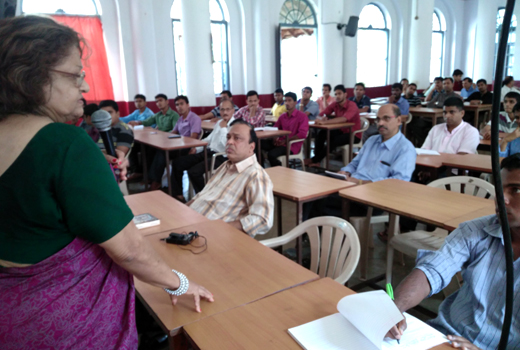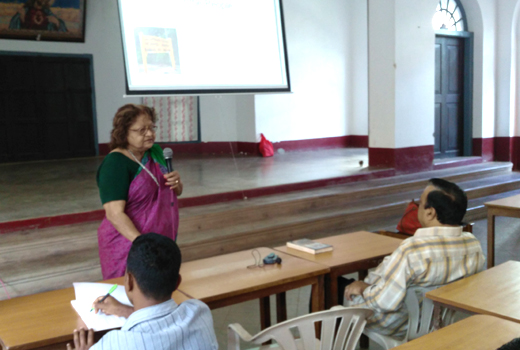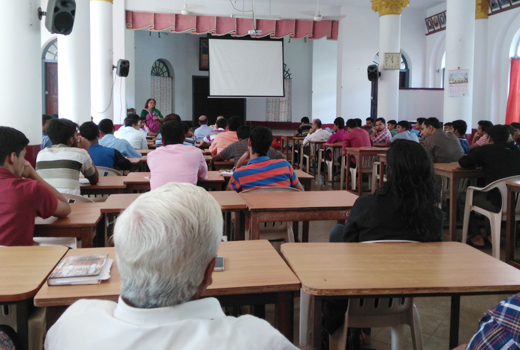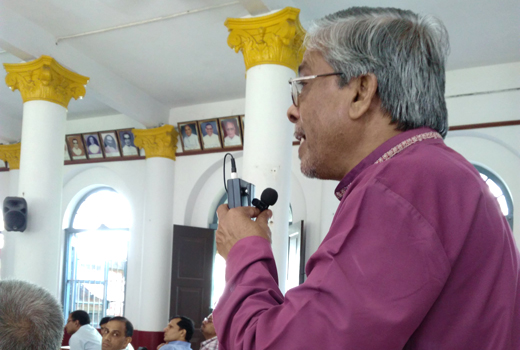Historian Dr.Kranti Kiran’s talk at Joseph’s seminary
Historian Dr.Kranti Kiran’s talk at Joseph’s seminary
Mangalore Today News Network
Mangaluru, Jan 11, 2018: Well known Mumbai based Kanara historian and daughter of freedom fighters, Dr. Kranti Kiran, introduced the religious scholars at historic St Josephs seminary Jeppu in the city to the outline of the Konkani ’Sarasvats’ migration to Kanara from Goa in the 1500s. Her candid narration of their reluctance to conversions and positive development in Tulunad’s just rulers was impressive. It is seen to go a long way in nurturing the interest in the minds of the young scholars and potential researchers. Members of the community attended out of interest and invitation of Dr. Kranti.




NOTE: On special request Dr. Kranti has scheduled to hold a talk on the possible connection of the ancient Konkani people with Jewish community even before they came to India from their land of origin. In this context people could volunteer to give blood samples for a DNA analysis and study.
The meet is scheduled from 10 am to 12 noon, tomorrow, January 12, Friday at Roshni Nilaya, Fr.Muller’s Road. Interested people may attend.
Recap: Till recent times the Konkani speaking communities of the West Coast have been resting on the fact that history confirms their Aryan descent in a Dravidian land and their disbursement from the now unseen River Saraswati a tributary of the River Sind when it became non-existent centuries ago. It was understood that the Aryans of Sind probably carried Greek genes. In the last five hundred years these Konkani speakers known to be Brahman Hindus have evolved into Muslims and Catholics too as is seen. These descendants of ancient Goud saraswat Brahmins (GSBs) today are spread all over the world intermingling with multi ethnic and linguistic societies. An established and well known Historian from the Konkani Catholic Community based in Mumbai, is set to soon come out with a book that traces back the ethnicity of Konkani speakers to Jewish Biblical roots - historical research is ever an on-going proposal. A complex project is under way and one segment of it is to possibly trace the earlier origins of the Konkani speakers before their sojourn on the banks of river Saraswati. Vague theories are a plenty some of them may have a basis. But, to set a bonafide direction twenty first century Scientists and researchers have many new tools presently. The latest genetic and computational technologies to analyze patterns in DNA from participants around the South West Coastal region of India are one of them. In it’s May 2014 issue, monthly English magazine "Mangalore Today" brought out a detailed story in this regard.
Dr.KRANTI K FARIAS and HER WORK: Dr. Kranti K. Farias is a former President of The Church History Association of India. Her doctoral work, entitled “The Christian Impact in South Kanara” was published in 1999; it is a work worth a read by all interested in the general ’History of South Kanara. She has published several articles and papers on Indian Nationalism, Indian Christians and Indian Jewish communities in India, Israel and Canada. It may be noted she is the daughter of Cyprian and Alice Alvares who resided in Bombay (Mumbai) and were active in Indian freedom struggle (I believe that is the reason she has the name ’Kranti’ meaning ;revolution;). Responding to the call of Civil disobedience movement 1942 - the Quit India movement’ against British rule, the Alvares couple were detained in jails on several occasions, like many freedom fighters, their lives have been worthwhile. Dr. Kranti ’s current area of research is the history of the Jewish communities in India and the Diaspora with special focus on the B’nei Menashe of North East India (Manipur & Mizoram States) and the Bene Ephraim (Telugu Jews of Hyderabad, Andhra Pradesh State, South India). She was Principal of St. Aloysius Gonzaga High School and Modern Indian School in Mumbai. She lectured at the St. Xavier’s College and R. D. National College in History and Political Science and was also a Lecturer-Teacher Educator at the Rizvi College of Education, all in Mumbai. She is working on a book on cultural comparison of the Indian Jewish and Indian Christian Communities. This will be an interesting exposé of two Semitic communities living in harmony in India, knowledgeable about their roots and proud of their heritage. The book is awaited with great expectation.
- Cyber fraud: With local help, foreign hands siphon Rs 49 cr from Bengaluru firm in 2 hours; 2 held
- Drunk teacher drives 750 metres with man on car hood after crash on Gujarat highway
- Living freely in Delhi, plan to remain in India: Sheikh Hasina
- Bengaluru couple chases biker for 2 km after minor accident, kills him
- Bangladeshi man chants religious slogans at Bengaluru temple, attacks idols
- Rohit Sharma, 38, becomes the oldest ever ICC No. 1 ODI batter, breaks Sachin’s world record
- President Murmu flies in Rafale Fighter from airbase key to Op Sindoor
- Fraudsters dupe Bengaluru businessman of Rs 1.32 crore with fake PFI link claim
- Amid Karnataka leadership tussle, Congress plans Dalit convention to strengthen ‘Ahinda’ base
- Cabinet approves guidelines for 8th pay commission; to benefit 50 lakh employees
- Cyclone Montha: Heavy rain batters AP, uproots trees; mudslides, power cuts hit Odisha
- Karnataka HC halts state govt order restricting RSS events, cites constitutional rights
- PM Narendra Modi to visit Udupi Sri Krishna Mutt on November 28
- Belthangady: Bike-car collision, rider succumbs to injuries
- Mangaluru: Unauthorized stalls cleared along Kadri Park Road
- Mangaluru: Couple arrested for duping people of crores with promise of overseas jobs
- Bantwal man missing after leaving for Bengaluru
- Mangaluru: K.S. Hegde hospital inaugurates advanced 3-Tesla MRI machine
- Bantwal: Auto-rickshaw driver missing after leaving vehicle on old Panemangalore bridge
- Melkar: One dead, four injured as car crashes into divider
- Mulki: Man dies by suicide on railway tracks at Indiranagar
- Sullia: Man arrested for sexually harassing minor girl
- Mangaluru: Red laterite stone prices remain high despite capital reduction
- Beltangady: Two held in raid on illegal beef unit; 91 kg meat seized
- Mangaluru: SAF personnel to learn Tulu language, culture to interact with locals, understand their concerns
- APD Foundation Joins WHO Civil Society Commission
- Daiva’s prediction comes true: Janardhan Reddy walks free from jail
- Skills and Competencies Take Center Stage at MSN Dialogue Series
- Court remands Maoist Lakshmi to six-day police custody
- Sandhya Shenoy honored with Society for Materials Chemistry Medal-2024
- White Cornus Apartment in Mangaluru
- City girl wins first place in state-level spell bee competition
- Alleged ‘Love Jihad’ Case in Mangaluru: Woman left home voluntarily, says police
- Girl fatally struck by reckless two-wheeler near Belman
- New residential complex for the judges inaugurated in Mangaluru
- Absconding accused nabbed after 8 years
- Truck with cylinders turns turtle in Beltangady
- Bhoota Kola artist dies of cardiac arrest
- Development of the country should be our goal: Ganesh Karnik
- Container truck gets stuck under Modankap railway bridge
- CITY INFORMATION
- TRAVEL
- TOURIST INFORMATION
- HEALTH CARE
- MISCELLANEOUS




 Write Comment
Write Comment E-Mail
E-Mail Facebook
Facebook Twitter
Twitter  Print
Print 

